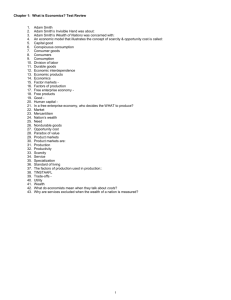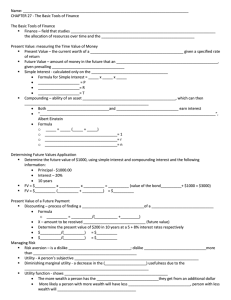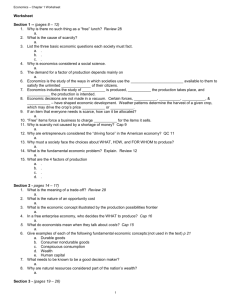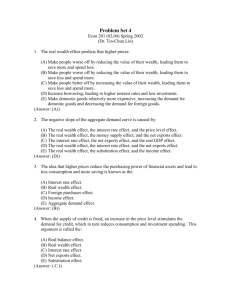engineering economics - E-books Library | NUST College of EME
advertisement
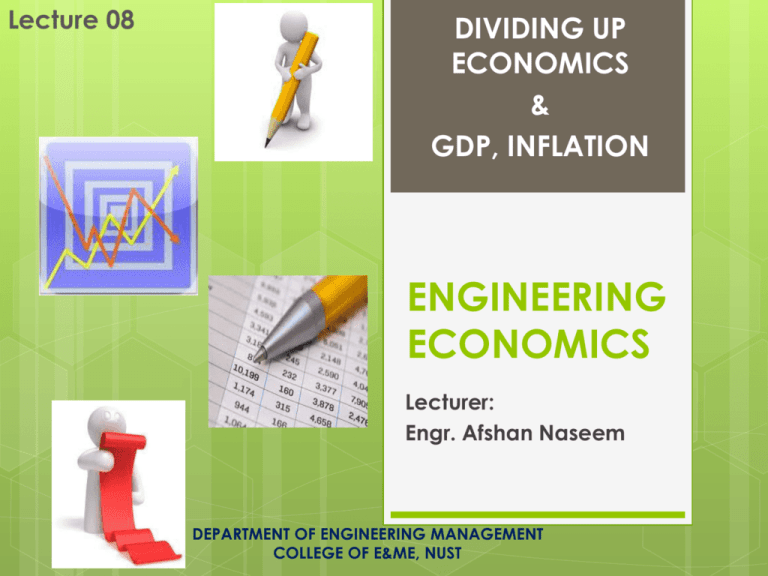
Lecture 08 DIVIDING UP ECONOMICS & GDP, INFLATION ENGINEERING ECONOMICS Lecturer: Engr. Afshan Naseem DEPARTMENT OF ENGINEERING MANAGEMENT COLLEGE OF E&ME, NUST Goods, Utility, Wealth, Value Goods Goods mean material merchandise which can be witnessed felt and shifted. Goods are classified into material and nonmaterial goods. Material goods are tangible, they can be noticed, handled and relocated. On the contra, non-material goods are intangible and they do not possess any character or power and cannot be observed, fingered or transmitted. Services of all types of goods such as doctors, engineers, lawyers, teachers etc., are nonmaterial goods. But both the types have values in monetary terms. Goods (contd.) Economic goods are those which has price and value. Their supply is generally lesser than the demand. Non-Economic goods are price free goods such as free gifts which has no price and are unlimited in supply. Air, water, light and heat are some examples of non-economic goods. Consumer goods are those which are readily be consumed and satisfies the needs to the customers directly. Whereas Producer's goods such as machinery, plants etc., serves the customers directly or indirectly. They help in production of other goods. Utility The needs fulfilling power of a product is called utility. It is a quality possessed by a product or service to satisfy human requirements. Utility is based on the following types. They are Forms Utility - When utility is created by changing its shape or form and consumed is termed as form utility. For instance, a wood is turned into a shape of furniture. Place Utility - With the example given above, if the furniture is taken to the work place, it becomes place utility. Utility (contd.) Time Utility - When a product is warehoused for the purpose of economic boom, it created time utility. Service Utility - When the professionals does service according to the needs of the customers forms the service utility. Possession Utility - If for instance, an Economics book on principles is been possessed by an economic student, then it creates possession utility. Value Value and Value-in-use are divergent meanings. Value in general means price value. For instance, if we are hungry and need food and nearby is a fruit tree which is easy accessible, then eating a fruit from the tree quenches hunger. This is known as Value-in-use. In economics value means value in exchange, where goods and services are exchanged for some consideration. Value in Price In general, the meanings of value and price is the same, which is money. In economics, value and price are two different terminologies. Price is value articulated in terms of money. Value is uttered in terms of other goods. Value is virtual concept in association to the concept of price. It means there cannot be a general rise or fall in values but prices can have rise or fall. Wealth Wealth means money, property, gold etc. But in economics it is used to portray all things that have value. For a product to be called wealth, it must posses utility, scarcity and transferability. In the event of lacking even one quality it cannot be connoted as wealth. Forms of Wealth Individual Wealth - Wealth owned by individuals is called private or individual wealth. Eg: House property, Gold, Vehicle Etc. Social Wealth - Goods owned by the society as a whole such as Temples, Roads, Forests Etc. National or Real Wealth - It includes individuals, society as a whole and its wealth. It comprises of material assets possessed by the society. National wealth is the real wealth. International Wealth - The UNO, UNESCO, WHO, IMF, World Bank consists of International wealth since all nations contribute towards the benefit of these organisations. Financial Wealth - Financial wealth is holding of money, stocks, bonds, etc. by individuals in the society. Financial wealth is expelled from national wealth. This is because money, stocks are held by individuals as wealth are claims against one another. DIVIDING UP ECONOMICS Economics It is made of Macro economics Micro economics Macroeconomics Macroeconomics is concerned with the economy as a whole. It is concerned with aggregate demand and aggregate supply. Aggregate Demand & Aggregate Supply By 'aggregate demand‘ means the total amount of spending in the economy, whether by consumers, by overseas customers for our exports, by the government, or by firms when they buy capital equipment or stock up on raw materials. By 'aggregate supply' we mean the total national output of goods & services. Microeconomics Microeconomics deals with individual parts of the economy. It deals with the demand and supply of particular goods and services and resources: Examples: cars, computers and coal. Scarcity Scarcity is the excess of human wants over what can actually be produced. Not all people face the problem of scarcity to the same degree. Example: A poor person is unable to afford enough to eat or a decent place to live. A rich person cannot afford a second Mercedes Benz. Thus the problem of scarcity is not an equal one. All people, both rich and poor, want more than they can have. Balance at the Micro and Macro levels Given the problem of scarcity, Potential demands will exceed potential supplies. It has to try to match demand and supply. Macro Level Demand = Supply at the level of the total or overall economy also. Thus Aggregate demand needs to be balanced with aggregate supply. This means that total spending in the economy must balance total production. Micro Level Demand = Supply at the level of individual goods and services. The demand and supply of video recorders and cars must also balance. Macro economics Macroeconomics studies 3 major issues: 1. the determination of national output and its growth over time. 2. It studies the problems of stagnation, unemployment, inflation, the balance of international payments and cyclical instability 3. Policies adopted by governments to deal with these problems. Inflation & Balance of Trade Inflation refers to a general rise in the level of prices throughout the economy. If aggregate demand rises substantially, firms are likely to respond by raising their prices. If demand is high, they can still sell as much as before (if not more) even at the higher prices, and thus make more profits. If firms in general put up their prices, inflation results. . Balance of trade deficits are the excess of imports over exports. If aggregate demand rises, people are likely to buy more imports. So they will spend on Japanese DVD players, German cars, etc. Also if inflation is high, home-produced goods will become uncompetitive with foreign goods. We are likely, therefore, to buy more foreign imports, and foreigners are likely to buy fewer of our exports. Unemployment & Recession If aggregate demand is too low relative to aggregate supply, this generally leads to unemployment and recession. A recession occurs when output in the economy declines: A recession is associated with a low level of consumer spending. If people spend less, shops are likely to find themselves with unsold stocks. If firms are producing less, they will need a smaller labor force. Thus cutbacks in production will lead to unemployment. GDP Gross Domestic Product (GDP) GDP is the primary measurement of economic performance. It is the dollar value of all final goods and services produced within a country’s borders in a given year. Pakistan GDP Growth Rate Pakistan GDP Growth Rate (contd) Calculation of GDP The most common method used to calculate GDP is called the expenditures method. This method adds up the amount of money spent on consumer purchases, business purchases, government purchases, and net exports (Exports minus Imports). GDP Limitations GDP is probably the best measurement of economic performance. However, there are primary limitations to GDP. GDP measurements do not include nonmarket activities, underground economic activities, negative externalities, and the overall quality of life. GDP & GNP INFLATION Inflation This is a rise in the general level of prices. There are two primary theories about what causes inflation. These are the demand-pull and cost-push theories of inflation. Demand-Pull Inflation This type of inflation is caused by an increase in consumer demand. Consumer demand literally pulls the price up. “Too much money chasing too few goods” is an old saying that explains demand-pull inflation. This means that the supply of goods can’t keep up with the demand for goods. Consumers will compete with one another for the goods, hence, bidding the prices up. Cost-Push Inflation This type of inflation is caused by an increase in input prices. This means that it costs more for manufactures to produce a good or provide a service. This increase in cost is then passed on to consumers. An increase in the price of oil will cause an increase in the price of many products. This is because oil is used in the production of many products including gasoline, chemicals, plastics, and pesticides. Planning for Capital Needs Capital: any form of wealth employed to produce more wealth Fixed capital: to purchase a company’s permanent or fixed assets such as land, buildings, computers, and equipment Working capital: to support a business’s short-term operations Growth capital: to finance a company’s growth or its expansion in a new direction Equity vs Debt Capital Equity capital: represents the personal investment of the owner (s) of a company Debt capital: the financing that a small business owner has borrowed and must repay with interest Bond A certificate of debt issued by a government or corporation guaranteeing payment of the original investment plus interest by a specified future date. Dividend: Profits of a firm that are distributed or given out to its investors (stockholders). Credit: The giving of goods and services in return for the promise of payment at a future time. The payment usually has interest attached. Tax A contribution for the support of a government required of persons, groups, or businesses. There are many different kinds of taxes including income, sales, state. local, federal taxes. Tariff: A tax on imports or exports by the government. DISCUSSION
